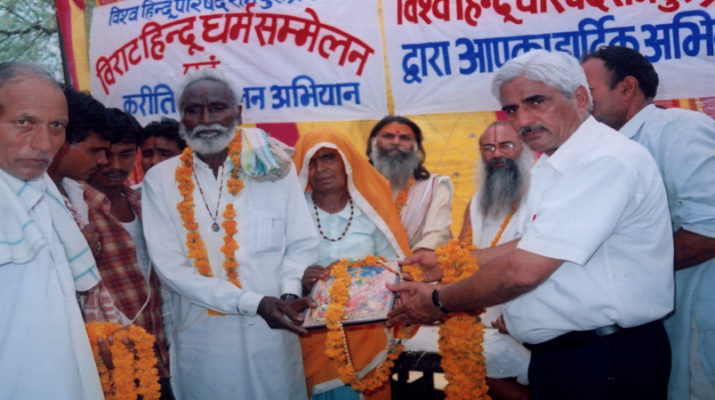Gopalbhai Ashar
1. Go-Sammelan
2. Dharmacharya-Sammelan
3. Matri-sammelan
4. Yuva-sammelans
5. Shiksha-sammelans
6. Helpful in widening the field and scope of work of the Parishad
Religious ceremonies (Anushthans) have been duly recognized by the Hindu society since times immemorial. The religious preceptors (Dharmacharyas), sages and seers, the kings and emperors, the mercantile class and other social and cultural organizations have been frequently holding and arranging massive religious rituals and ceremonies. From the Vedic times to the modem day grand yajnas and yagas involving devotional and sacrificial oblations, religious assemblies, discussions about the worldly knowledge (Vijnana) and the knowledge of the Supreme Spirit (Jnana); narration of tales and sermons (kathas and pravachnas), congregational hymn-singing (samkirtana), performing of pilgrimages to holy places and shrines (tirth-yatras), religious performances etc. on the individual or collective levels have been the various types of religious undertakings which have kept the Hindu society unified and have otherwise been beneficial to it in a multiple ways.
The young generations of the Hindu society have been, continually denied and deprived of our spiritually-oriented life-pattern and ideology due to the alien culture-oriented education, ignorance of the satvik basis of our righteous life-style and the lifeless modernity of the present mechanical age. Craving for worldly prosperity, self-seeking and the cultivation of one’s contracted sewa instead of a life of sacrifice, forbearance, service, and devotion to duty; good conduct, etc. is perverting our ideology and destroying our very basis. This deformation of the society can to a large extent be corrected by recourse to the religious anushthanas.
Types of Anushthans
Prior to the advent of kaliyuga great yajnas, like the Rajsooya yajna the Ashwamedha yajna, the Som yajna, were performed by the great sages and seers and the Chakravarti Samrat as also ordinary citizens used to participate in them with joy and zeal. These yajnas were the symbols of the well being of the ruler and the ruled, plentifulness of cereals and water and development and prosperity of the nation as well as its sovereignty.
These days also great yajnas such as Sri Vishnu yajna, Maha-Rudra yajna are performed as per the belief, the means, and the desire of the performer. In addition to these, nowadays, the reading parayan and katha-jnana-yajna of Srimadbbhagwata and Sri Ramayana are also popular. These yajnas are performed on the individual and the family level as well as on the social and public level. Such yajna-anushtbans are also these days being instrumental in the collection of monetary donations for the service and help of the suffering humanity.
Apart from the above-mentioned yajnas etc. the religious exhibitions, cultural programs, religious assemblies, and conferences, etc. play an effective role in realigning with the society of the young generation and of those who -had somehow got alienated from the mainstream of the society.
Utility of Anushthans
The anushthans performed collectively have been contributing a lot to unifying the Hindu society and in impressing purificatory cultural imprints (samkars) on the young generation. People have a natural curiosity and desire for knowing the contents and teachings of the scriptures of the country. Undoubtedly, the anushthans could prove very efficacious in creating and promoting ‘adhyatmikta’ that is a spiritual awakening among the masses of the country.
Liaison with the Learned
Vajna-anushthans are executed by the pandits who are learned and at the same time well-versed in the ritualistic performance. When such anushthans are arranged by the VHP workers, naturally the learned pandits happen to come in contact with the Parishad and consequently come to realize the immensity of the Hindu awakening endeavor undertaken by the Parishad. They also get acquainted with the multifaceted problems of the Hindu society and their proposed solutions. They are also able to appreciate the importance of their possible contribution to the spiritual and religious development of the society. Having realized their social responsibility, they gradually come out with increasing zeal and zest to fulfill the same. In this way, their relationship with the society becomes more intense and cordial.
Yajnas Counteract ill-effects of Pollution
Various types of environmental pollutions have adversely affected not only the life of us Indians but the whole of the world as well. These pollutions have contaminated not only the natural wealth of our country but also the inherent sentiments behind the Hindu thought process. The W-effects of the pollution have been compounded by the lack of awareness about its consequences and the pressure of the growing population. Modern science has not yet been able to completely get rid of this menace to human life and civilization. Yajnas can to a large extent remove these pollutions as they are basically scientific in their nature.
Vajnas Strengthen Spiritual and Cultural Background
As mentioned above, in addition to the pollution of the environment, the Hindu society is also suffering from ideological pollution. We are becoming oblivious of our spiritual and cultural background because of our longing for modernity. Our sages and seers have always emphasized the sublime ideals of Vasudhaiva kutambakam that is “the whole world is our family” and “survey bhavantu sukhinah ” that is “let all be happy”. We are equally ignoring the essentiality of the performance of the yajnas, havens, recitation of mantras and the ahutis comprising the forest herbs and plants and the ghee obtained from cow-milk, and also not abiding -by the golden principles of service, sacrifice, forbearance, ethical conduct, dedication towards truth, etc. In the Vedic Times, we used to achieve and accomplish the worldly (i.e., the laukik) as well as the other worldly (i.e., paar-laukik,) success and fulfillment through yajna-anushthans. Vajnas not only purified and sanctified the atmosphere, victory over asuri powers, that is, those having the evil bent of mind, was also achieved through yajnas. From the yajna-devata we sought the salutary powers of the nature and also the powers of gods for the ultimate good of the people. The yajna-anushtbans mentioned in the Ramayana and the Mahabharta are the proof positive of this.
Scientific Basis of the Hindu Yajnas
The Western scientists are also accepting the advantages of the Bharatiya yajnas. They confirm that the sacred smoke emanating from the yajna fires cleans and improves the atmosphere. Even now many scientists in the developed, as well as the developing countries, are engaged in research on this project. We are confident that Bharat too will endeavor in a proper way to again rehabilitate the beneficial practice of yajans in the minds of the people.
Role Anushthans in Awakening the People
Vast number of people usually join the performance of a religious anushthan. Apart from the yajna, conferences and seminars on the burning issues and topics are also arranged on the occasion.
Sammelans especially directed to go-Raksha, (cow-protection), dharmachryas, vidyans, the mothers, the teachers, the children, the youth, the vanavasis are some such sammelans. These go a long way in informing and awakening and in mobilising the respective audiences. Some salient features of the various types of sammelans have been elaborated below.
1. Go-Sammelan
Through the medium of this sammellan, the directors and managers of go-shalas, the go bhaktas, the government officials and the organizations and institutions engaged in cow-promotion and cattle-breeding come together at a single forum and consider ways and means of protecting the cow and its progeny. On the basis of statistics and available data it is sought to prove incontrovertibly that the cow has its importance not only from a religious point of view but that even from an economic point of view, it is useful and self-reliant. The attention of the people and the administration is drawn to the fact that cow-protection work is immensely useful for the people in general. Through such sammellans those devoted to the service of the cow, the go-sevaks and the go-bhakts come in close contact with the Parishad and their co-operation and collaboration are made available to the Parishad.
2. Dharmacharya-Sammelan
Dhannacharyas have a special and respected position in society. They have lakhs of devotees in their respective areas, who get inspiration and guidance from their directions and sermons. They play a major role in unifying the country. The Parishad invites the dhamacharyas to grace the sammelans by their presence. It also serves as a medium in assembling the audience and making available to it the guidance of the saints. Through such sammelans the dharmacharyas get associated with the Parishad and through their active co-operation have bestowed honor and glory to the Parishad.
3. Matri-sammelan
Mothers’ meeting on the occasion of the anushthan has its own unique importance. The unifying of the mother power, their acquaintance with the cultural and religious heritage of Bharat, and of being instrumental in making their children patriotic and inclined towards dharma and ethical behaviour, is a crying need of the day. Mothers are the living symbols of faith and sacrifice. Mother-power has a unique place of honor for keeping the banner of dharma flying because of their deep faith and conviction. Our history is replete with glaring tales and episodes of their gallantry, supreme sacrifice of their life, of renunciation and devotion. The worthy women of Bharat have always, been the objects of adoration. The observance of the Jauhar vow in Rajasthan is the unparalleled example of the supreme sacrifice of life by the woman for her self-respect and self-protection. Therefore, in the present-day context, the successful holding of matri-sammelans is extremely essential. It is imperatively necessary to inspire eminent women of the specific regions to come forward for the eradication of bad customs and practices and for imprinting good samskaras on the family members. The cupidity visible in the present-day cinema, the depiction of the women as an ignoble one in literature, and the mockery of our deities, the gods and goddesses in movies, the violence, fashion, vulgarity, and sensuality are some of the challenging issues on which the women have to take concerted remedial action. Thus to bring awareness and awakening in the women, the matri-sammelan are held whenever dharmic anushthans are arranged.
4. Yuva-sammelans
The youth are the symbols of the purusharth, that is, the industriousness, the virility of the society and the country. It is only an awakened youth, that is, the combined strength of the ready-to-sacrifice and new generation that could bring prosperity to the country. It can defeat the enemies of the country and make Bharat a nation as 0-powerful and at its pinnacle of glory. It is from the forum of the yuva-sammellan (Youth Meet) that the torch challenging the new generation to come forward forthwith for the protection of the dhama and the society is handed over to them and their active cooperation is sought. To achieve precisely these objectives the yuva-sammelans are organized on the occasion of dharmic annushthans.
5. Shiksha-sammelans
Through the educational meets the teachers and office-bearers of the schools, colleges and other educational institutions and the workers of social organisations are brought together on a common platform and contacts with them are intensified so that efforts could be made to give concrete form, in the field of education, to the fundamental tenets and principles of Hinduism. The role of the teachers is that of the builders of the nation, while the students are the promising symbols of the future the tomorrow of the nation. In their joining together lie dormant the ~s of the new revolution. By activating contacts with them through the machinery of the Parishad, the seed can be converted into a massive banyan tree. This is the purpose behind organizing Yuva-sammelans by the Parishad.
6. Helpful in widening the field and scope of work of the Parishad
The anushthans have proved to be an efficacious medium for expanding and publicizing the activities of the Parishad. Anushthans occasion the establishment of contacts with the up and coming opinion leaders and other professionals of the society, such as the journalists, news correspondents, authors, scholars, businessmen, government officers and administrators and they get acquainted with the Parishad, its aims and objects, and its multifarious activities and service projects and a permanent relationship is developed with them. It is suggested that under the flag of the Parishad yajnas, anushthans and sammelans on a grand scale be arranged at important places throughout the Hindu society, from Himalayas to the seas, so as to create a sense of unity despite the distinctions and differences in their rites and rituals, customs and practices, and in their dress, and even languages, etc.



